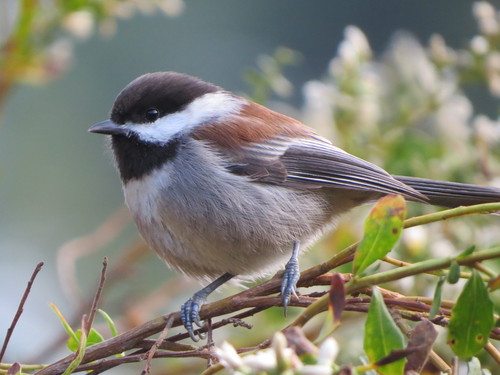
Chestnut-backed Chickadee
The Chestnut-backed Chickadee (Poecile rufescens) is a small, energetic songbird native to the Pacific Northwest of North America. It is known for its distinctive rich chestnut-brown back and flanks, contrasting with a black cap and bib, and white cheeks. This species plays an important ecological role as an insectivore, helping to control forest insect populations. It is a common resident of coniferous and mixed forests, often found in close proximity to human habitation, readily visiting bird feeders. The Chestnut-backed Chickadee holds no particular widespread cultural significance but is appreciated by birdwatchers for its lively behavior and charming appearance.
11.5-12.5 cm
Length
16-18 cm
Wingspan
Least Concern
Conservation Status
Distribution
The Chestnut-backed Chickadee is found along the Pacific coast of North America, from southern Alaska south through British Columbia, Washington, Oregon, and into northwestern California. Its range extends inland to the western slopes of the Cascade Mountains and, in some areas, the Sierra Nevada. It is generally non-migratory, although some populations may undertake short altitudinal movements in winter.
Lifespan
The average lifespan in the wild is estimated to be 2-3 years, but some individuals have been recorded living up to 10 years.
Chestnut-backed Chickadee's Habitat
Habitat Types
Coniferous forests, Mixed woodlands, Riparian areas, Suburban gardens and parks
Climate Zones
Temperate, Boreal (in the northern part of its range)
Adaptations
Chestnut-backed Chickadees are well-adapted to foraging in dense coniferous foliage. Their small size and agility allow them to access insects and seeds in tight spaces. They also exhibit caching behavior, storing food in bark crevices and other hidden locations for later retrieval, an adaptation to seasonal food scarcity.
Variations
Three subspecies are generally recognized: *P. r. rufescens* (along the coast from Alaska to Oregon), *P. r. neglectus* (in coastal California), and *P. r. barlowi* (in the Santa Cruz Mountains of California). These subspecies show slight variations in plumage color and size.
Appearance
Breeding Plumage
Plumage is generally consistent year-round.
Seasonal Feather Changes
No significant seasonal variations.
Sex Based Plumage Differences
Males and females have very similar plumage.
Notable Features
Rich chestnut-brown back and flanks, Black cap and bib, White cheeks, Short, black bill
Diet and Feeding
Primary Foods
Insects, Spiders, Seeds, Berries
Foraging Behavior
Chestnut-backed Chickadees are active foragers, gleaning insects and spiders from leaves, branches, and bark. They often hang upside down to examine the undersides of branches. They also readily consume seeds and berries, especially during the winter months.
Specializations
Their small, pointed bill is well-suited for probing into crevices and extracting small insects. Their caching behavior is a significant specialization for surviving periods of food scarcity.
Seasonal Diet Variations
The diet shifts seasonally, with a greater reliance on insects and spiders during the breeding season and an increased consumption of seeds and berries during the fall and winter.
Behavior
Social Structure
Chestnut-backed Chickadees are often found in pairs or small family groups during the breeding season. In the winter, they may form mixed-species flocks with other small songbirds, such as kinglets and warblers.
Communication
Complex vocalizations, including a variety of calls and songs, The 'chick-a-dee' call, which gives the chickadee family its name, is used for contact and alarm., Males have a more complex song used for territorial defense and mate attraction.
Migration
Generally non-migratory, although some populations may move to lower elevations in winter.
Territorial or Group Behaviors
Pairs defend small territories during the breeding season. In winter, they are less territorial and may forage in larger, mixed-species flocks.
Conservation
Threats
Habitat loss due to logging and urbanization, Climate change, which may alter forest ecosystems, Competition with invasive species
Protection Programs
Protection of mature and old-growth forests, Habitat restoration projects, Provision of nest boxes in areas with limited natural cavities
Local National Laws
Protected under the Migratory Bird Treaty Act in the United States and similar legislation in Canada.
Population Trend
Stable
Population Estimates
The global population is estimated to be around 13 million individuals.
Interesting Facts
They have excellent spatial memory.
This allows them to remember the locations of thousands of cached food items.
They can lower their body temperature at night.
This is a form of torpor, which helps them conserve energy during cold weather.
New neurons grow in their brain.
The hippocampus, the part of their brain that stores spatial memory, grows new neurons in the fall to help with the increased demand of remembering cache locations.
Faqs about Chestnut-backed Chickadee
What can I feed Chestnut-backed Chickadees?
They readily eat black oil sunflower seeds, suet, peanuts, and mealworms at bird feeders.
Do Chestnut-backed Chickadees use birdhouses?
Yes, they will readily use nest boxes, especially those filled with wood shavings or sawdust.
How can I tell a Chestnut-backed Chickadee from other chickadees?
The combination of the chestnut-brown back and flanks is unique to this species among North American chickadees.
Copyright @ Nature Style Limited. All Rights Reserved.
 English
English